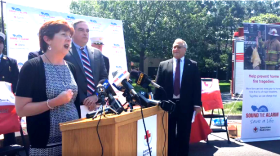Schenectady Mayor Gary McCarthy was in Washington to testify before the House Energy and Commerce Committee this week.
New York Congressman Paul Tonko of the 20th District invited Schenectady Mayor McCarthy to be among five panelists to testify Tuesday.
“The honorable Gary McCarthy, mayor of the great city of Schenectady, New York. A very thoughtful leader, a progressive leader and one who has brought great vision to leading the city of Schenectady, which is dubbed the Electric City,” Tonko said.
Mayor McCarthy testified as the committee explores improving the nation’s infrastructure. He highlighted the Smart City Initiative that Schenectady is implementing, and said that while the city is converting streetlights to LED fixtures, there is opportunity for additional features.
“Environmental sensors — temperature-precipitation, device based utility grade meters — this will allow different owners to place devices on a light pole and pay for the electricity used by just their device, optical sensors deterrence & documentation for policing — traffic and pedestrian analytics dimming controls for additional electricity savings, acoustic sensors, Wi-Fi and cellular communication protocols are just a few of the possible additions to a standard light pole,” McCarthy said.
McCarthy emphasized Schenectady’s partnership with National Grid in designing the Smart City project, part of the New York Governor Andrew Cuomo's Reforming Energy Vision program. The goal is to reduce 80 percent of greenhouse gas emissions by 2050.
“The 80 by 50 challenge is a significant goal and will require fundamental changes, which means that the early cost savings and sustainable applications of Schenectady and National Grid initiatives could serve as a model for other communities and utilities," McCarthy said. "This type of project has the potential to transform communities and has clear implications for the global competitiveness of this country. But it is based on a stable and adaptable electrical grid.”
McCarthy was asked about the logistics of switching more than 5,000 light poles in the city.
“So the 500 the city owns fairly easy to deal with. Where you get the utility owned street lights it becomes a more complicated process to either buy those or purchase the residual value of the fixtures that had been installed," McCarthy said. "That is why we are trying to work with National Grid, New York Public Service Commission to come up with a model that would allow that transition to the LED lights and when you are doing that as not to miss the opportunity to put some of that other available technology on the light pole.”
And McCarthy says the savings would be immense: $400,000 initially, about half of the city’s electrical costs. McCarthy says that could be just the start.
“When you put some of the either the Wi-Fi or cellular communication protocol on the pole you might be able to extend that savings to residents and businesses,” McCarthy said.
It was the 47th hearing by the House Energy and Commerce Committee on America’s infrastructure.










